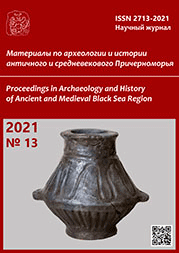Ранневенгерское погребение с декоративными обувными накладками у с. Глиное
Early Hungarian grave with decorative shoe soles near the Glinoe village
Author(s): Maksym V. Kvitnytskyi, Nicolai P. Telnov, Attila TürkSubject(s): History, Archaeology, Cultural history, Ancient World
Published by: Нижневартовский государственный университет
Keywords: Left bank of the Lower Dniester; ancient Hungarians; the middle of the 9th — the beginning of the 10th century; metal shoe soles;
Summary/Abstract: The article deals with the Early Hungarian grave Glinoe/Vodovod (‘Water distribution system’) 4/1 investigated in 2016 near Glinoe village, Slobodzeya district, on the left bank of the Lower Dniester and erroneously interpreted in 2017 as a Scythian burial; the burial pit, however, was indeed dug through the mound of a Scythian barrow. The grave inventory consisted of golden foil and two gilded plates of silver, the fact which made it possible to set the burial within the time range from the middle of the 9th century until the beginning of the 10th century. Taking into account the radiocarbon dating, the time of the interment can be limited more accurately between the years 850 and 870. Appliqués of gold and silver are basically found in female burials of the Hungarians elsewhere in the Carpathian Basin and are thought to have been footwear adornments. The investigated grave not only supplements the list of sites marking the habitat of the Hungarian tribes in the Northwest Black Sea region before finding their homeland, but is also a part of the representative group of Hungarian burials discovered near Glinoe village. It is argued therefore that some large family or a tribal clan have inhabited the micro-region, just like they most probably did when the burial ground was established in the area around present-day Slobodzeya.
Journal: Материалы по археологии и истории античного и средневекового Причерноморья
- Issue Year: 2021
- Issue No: 13
- Page Range: 603-618
- Page Count: 16
- Language: Russian

